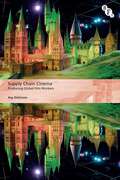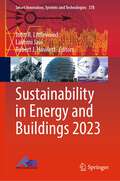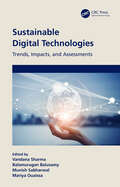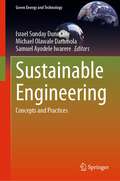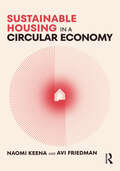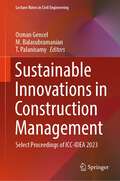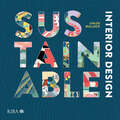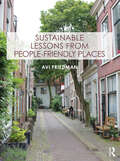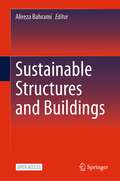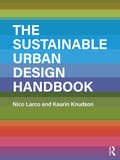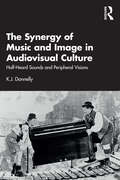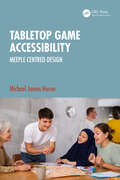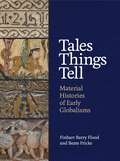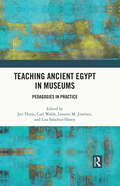- Table View
- List View
Supply Chain Cinema: Producing Global Film Workers (International Screen Industries)
by Kay DickinsonWhy are big budget films typically made across an array of seemingly dissociated sites? Supply Chain Cinema shows how the production journeys of such films exemplify the principles of the supply chain, whose core imperative is to nimbly and opportunistically manufacturing wherever is most amenable and efficient.Through extensive on-site investigations and in-depth interviews with film professionals, Kay Dickinson delivers nuanced insight into working practices in the UK and the UAE. Among the sites she examines is Warner Bros' permanent base at Leavesden Studios near London. From tax breaks designed to attract foreign projects to infrastructures, logistical support and expertise offered, she considers why Hollywood giants elect to make more of their films in Britain than in the USA. Dickinson goes on to show how the UK's ambitions to enlarge its creative economies has opened up a host of competitive advantages with British higher education increasingly fashioned to conform to the needs of border-hopping enterprise, thus generating a workforce keenly adapted to the demands of blockbuster moviemaking.
Sustainability in Energy and Buildings 2023 (Smart Innovation, Systems and Technologies #378)
by John R. Littlewood Lakhmi Jain Robert J. HowlettThis book contains the proceedings of the 15th KES International Conference on Sustainability and Energy in Buildings 2023 (SEB2023) held in Bari, Italy, during September 18–20, 2023, organized by KES International. SEB23 invited contributions on a range of topics related to sustainable buildings and explored innovative themes regarding sustainable energy systems. The conference formed an exciting chance to present, interact, and learn about the latest research and practical developments on the subject. The conference attracted submissions from around the world. Submissions for the full-paper track were subjected to a blind peer-reviewed process. Only the best of these were selected for presentation at the conference and publication in these proceedings. It is intended that this book provides a useful and informative snapshot of recent research developments in the important and vibrant area of sustainability in energy and buildings.
Sustainable Digital Technologies: Trends, Impacts, and Assessments
This book is a reference on digital technology and its impact on sustainability, providing insight into sustainable practices globally. It focuses on the critical practices leading to sustainable initiatives among various organizations, IT infrastructure, communities, and government compliance. The book describes the green computing paradigms and the impact of a circular economy with a focus on sustainable practices in a post-pandemic world. Sustainable Digital Technologies: Trends, Impacts, and Assessments discusses the critical factors leading to sustainable initiatives in a global economy. It highlights the impact of digital technology and Industry 4.0 in today’s world. The book focuses on the role, responsibility, and the effect of the Internet of Things for digital sustainability and practices. It describes implementation strategies for green cloud computing and presents additional strategies for sustainable practices in a post-pandemic world. This publication is designed for use by technology development academicians, data scientists, industrial professionals, researchers, and students interested in uncovering the latest innovations in the field and the current research on problem-oriented processing techniques in sustainable and evolutionary computing applications with reduced energy channelization.
Sustainable Digital Technologies: Trends, Impacts, and Assessments
by Vandana Sharma, Balamurugan Balusamy, Munish Sabharwal, and Mariya OuaissaThis book is a reference on digital technology and its impact on sustainability, providing insight into sustainable practices globally. It focuses on the critical practices leading to sustainable initiatives among various organizations, IT infrastructure, communities, and government compliance. The book describes the green computing paradigms and the impact of a circular economy with a focus on sustainable practices in a post-pandemic world. Sustainable Digital Technologies: Trends, Impacts, and Assessments discusses the critical factors leading to sustainable initiatives in a global economy. It highlights the impact of digital technology and Industry 4.0 in today’s world. The book focuses on the role, responsibility, and the effect of the Internet of Things for digital sustainability and practices. It describes implementation strategies for green cloud computing and presents additional strategies for sustainable practices in a post-pandemic world. This publication is designed for use by technology development academicians, data scientists, industrial professionals, researchers, and students interested in uncovering the latest innovations in the field and the current research on problem-oriented processing techniques in sustainable and evolutionary computing applications with reduced energy channelization.
Sustainable Engineering: Concepts and Practices (Green Energy and Technology)
by Israel Sunday Dunmade Michael Olawale Daramola Samuel Ayodele IwarereSustainable Engineering: Concepts and Practices provides insights into current perspectives on sustainable engineering research. It highlights the drivers, motivations, and challenges affecting the development and adoption of sustainable engineering in various sectors of the economy and how they impact sustainable development. Contributions from researchers representing multiple branches of engineering in academia, government laboratories, and industry present alternative approaches to traditional engineering practices. These approaches effect change, making the design, construction, production, and management of products, processes, and systems more environmentally friendly, socially beneficial, and economically profitable. The book will be a trusted reference for graduate students, practicing engineers, and other professionals interested in developing or using sustainable products and systems.
Sustainable Housing in a Circular Economy
by Naomi Keena Avi FriedmanThis book relates circular economy principles to housing design and construction and highlights how those principles can result in both monetary savings, positive environmental impact, and socio-ecological change.Chapters focus on three key circular economy principles and apply them to architectural construction and design, namely rethinking of the end-of-use phase of a building and the potential of design-for-disassembly; the role of digitization and data standardization in fostering evidence-based circular economy design decision-making; and presenting space as a resource to conserve, via exploration of the sharing economy and flexibility principles. Beyond waste management and material cycles, this book provides a holistic understanding of the opportunities across the building life cycle that can allow for sustainable and affordable circular housing. With case studies from 13 different countries, including but not limited to the Hammarby Sjöstad district in Sweden, the Circle House in Denmark, Benny Farm in Canada, VMD Prefabricated House in Mexico, and the Deep Performance Dwelling in China, authors pair theoretical frameworks with real-world examples.This will be a useful resource for upper-level students and academics of architecture, construction, and planning, especially those studying and researching housing design, building technology, green project management, and environmental design.
Sustainable Housing in a Circular Economy
by Naomi Keena Avi FriedmanThis book relates circular economy principles to housing design and construction and highlights how those principles can result in both monetary savings, positive environmental impact, and socio-ecological change.Chapters focus on three key circular economy principles and apply them to architectural construction and design, namely rethinking of the end-of-use phase of a building and the potential of design-for-disassembly; the role of digitization and data standardization in fostering evidence-based circular economy design decision-making; and presenting space as a resource to conserve, via exploration of the sharing economy and flexibility principles. Beyond waste management and material cycles, this book provides a holistic understanding of the opportunities across the building life cycle that can allow for sustainable and affordable circular housing. With case studies from 13 different countries, including but not limited to the Hammarby Sjöstad district in Sweden, the Circle House in Denmark, Benny Farm in Canada, VMD Prefabricated House in Mexico, and the Deep Performance Dwelling in China, authors pair theoretical frameworks with real-world examples.This will be a useful resource for upper-level students and academics of architecture, construction, and planning, especially those studying and researching housing design, building technology, green project management, and environmental design.
Sustainable Innovations in Construction Management: Select Proceedings of ICC-IDEA 2023 (Lecture Notes in Civil Engineering #388)
by Osman Gencel M. Balasubramanian T. PalanisamyThis book presents the select proceedings of International Conference on Civil Engineering: Innovative Development in Engineering Advances (ICC IDEA 2023). This book covers the latest research in the areas of construction engineering and management, urban planning and design, building energy conservation and green architecture, materials science and engineering, innovation in construction materials, and information technology in civil engineering. The book is useful for researchers and professionals in civil engineering.
Sustainable Interior Design
by Chloe BullockWhat does it mean to be a sustainable interior designer? Where do you start? This book demystifies how to be a sustainable interior designer, both within practice and on design projects. It gives you the tools to educate clients that sustainable practice isn’t necessarily more expensive, and what the options available to them are in terms of design concept, materials and finishes. Importantly, the book also looks at sustainable supply chains, particularly important when specifying FF+E. Where to start being sustainable can be a difficult decision. Acting as a primer for interior designers at any stage of their career, it outlines what you really need – and don’t need – to know. Inspirational case studies from around the world sit alongside crucial guidance on the benefits of being sustainable and how to work with enlightened clients. There is information on how sustainable design contributes to health and wellbeing, all backed up by authoritative best practice guidance.
Sustainable Interior Design
by Chloe BullockWhat does it mean to be a sustainable interior designer? Where do you start? This book demystifies how to be a sustainable interior designer, both within practice and on design projects. It gives you the tools to educate clients that sustainable practice isn’t necessarily more expensive, and what the options available to them are in terms of design concept, materials and finishes. Importantly, the book also looks at sustainable supply chains, particularly important when specifying FF+E. Where to start being sustainable can be a difficult decision. Acting as a primer for interior designers at any stage of their career, it outlines what you really need – and don’t need – to know. Inspirational case studies from around the world sit alongside crucial guidance on the benefits of being sustainable and how to work with enlightened clients. There is information on how sustainable design contributes to health and wellbeing, all backed up by authoritative best practice guidance.
Sustainable Lessons from People-Friendly Places
by Avi FriedmanCurrent planning and design modes of cities are facing challenges of philosophy and form. Past approaches no longer sustain new demands and call for innovative thinking. In a world that is becoming highly urbanized, the need for a new outlook is propelled by fundamental global changes that touch upon environmental, economic and social aspects.The book introduces fundamental principles of timely sustainable urban design, paying attention to architecture, integration of natural features, public urban spaces and their successful use. Readers will learn how cities are transitioning to active mobility by placing the wellbeing of citizens at the heart of planning; making buildings fit nature; supporting local culture through preservation; and including community gardens in neighborhoods, among others. Written by a practicing architect, professor and author, the book is richly illustrated and features meticulously selected international case studies.
Sustainable Lessons from People-Friendly Places
by Avi FriedmanCurrent planning and design modes of cities are facing challenges of philosophy and form. Past approaches no longer sustain new demands and call for innovative thinking. In a world that is becoming highly urbanized, the need for a new outlook is propelled by fundamental global changes that touch upon environmental, economic and social aspects.The book introduces fundamental principles of timely sustainable urban design, paying attention to architecture, integration of natural features, public urban spaces and their successful use. Readers will learn how cities are transitioning to active mobility by placing the wellbeing of citizens at the heart of planning; making buildings fit nature; supporting local culture through preservation; and including community gardens in neighborhoods, among others. Written by a practicing architect, professor and author, the book is richly illustrated and features meticulously selected international case studies.
Sustainable Structures and Buildings
by Alireza BahramiThis open access book includes detail on various structures, buildings, and building materials from different structural and sustainability perspectives. It describes how the building industry is vital for the achievement of the sustainable development goals, namely, economic growth, social progress, and the effective protection of the environment. The aim of this collection is to foster the design and construction of sustainable structures and buildings to reduce the environmental load, connect with the environment, and benefit the health of occupants. Presenting the knowledge, trends, and developments from a group of contributors in the field working with different kinds of structures, structural components, buildings, and building materials, the book is ideal for practitioners working in commercial settings, as well as engineering students and researchers concerned with sustainability issues.
The Sustainable Urban Design Handbook
by Nico Larco Kaarin KnudsonThe Sustainable Urban Design Handbook gathers the best sustainability practices and latest research from the fields of architecture, landscape architecture, planning, development, ecology, and environmental engineering and presents them in a graphically rich and accessible format that can help guide urban design decisions in cities of all sizes.The book presents a comprehensive framework that organizes more than 50 elements of sustainable urban design under five main topics–Energy Use & Greenhouse Gas, Water, Ecology & Habitat, Energy Use & Production, and Equity & Health–and relative to four project scales: Region & City, District & Neighborhood, Block & Street, and Project & Parcel. Each element chapter includes a summary of importance and background, compares typical practices and recommended approaches, explains connections to other elements, and concludes with urban design guidelines that can be used to directly inform projects and decisions.Easy to use and reference, The Sustainable Urban Design Handbook provides both an in-depth introduction to topics across sustainable urban design and serves as an on-going reference for anyone involved in the creation of sustainable urban environments. This resource will be useful to design and planning professionals, community members, students, and elected officials in guiding decisions about our sustainable future.
The Sustainable Urban Design Handbook
by Nico Larco Kaarin KnudsonThe Sustainable Urban Design Handbook gathers the best sustainability practices and latest research from the fields of architecture, landscape architecture, planning, development, ecology, and environmental engineering and presents them in a graphically rich and accessible format that can help guide urban design decisions in cities of all sizes.The book presents a comprehensive framework that organizes more than 50 elements of sustainable urban design under five main topics–Energy Use & Greenhouse Gas, Water, Ecology & Habitat, Energy Use & Production, and Equity & Health–and relative to four project scales: Region & City, District & Neighborhood, Block & Street, and Project & Parcel. Each element chapter includes a summary of importance and background, compares typical practices and recommended approaches, explains connections to other elements, and concludes with urban design guidelines that can be used to directly inform projects and decisions.Easy to use and reference, The Sustainable Urban Design Handbook provides both an in-depth introduction to topics across sustainable urban design and serves as an on-going reference for anyone involved in the creation of sustainable urban environments. This resource will be useful to design and planning professionals, community members, students, and elected officials in guiding decisions about our sustainable future.
Symbolism, Cognition and Communication in Architecture: Communities, Spatial Order and Architecture
by Abraham GeorgeThis book discusses the role and significance of symbols and symbolism in graphical communication toward the establishment of meaningful architecture. It explores how these are effectively applied in architectural education for the empowerment of learners in various cultures around the world. The volume examines the developments in graphic representations while recognizing the importance of cognition and its perception in spatial terms. In a scenario where architectural education is at crossroads, facing challenges of a global nature, this book highlights the importance of understanding architectural curriculum and design subjects. The author discusses the issues of communicating the knowledge of architecture to heterogeneous groups of students and explains how design fields and learning in architecture can be modified through cognitive instructional methods. The book outlines the methodology to develop symbols and symbolic pedagogical tools for effective communication in architecture. The book will appeal to students, researchers, teachers and scholars of architecture, design, planning and visual communication. It will also be of interest to architects, artists, spatial designers, town planners, urban planners and professionals.
Symbolism, Cognition and Communication in Architecture: Communities, Spatial Order and Architecture
by Abraham GeorgeThis book discusses the role and significance of symbols and symbolism in graphical communication toward the establishment of meaningful architecture. It explores how these are effectively applied in architectural education for the empowerment of learners in various cultures around the world. The volume examines the developments in graphic representations while recognizing the importance of cognition and its perception in spatial terms. In a scenario where architectural education is at crossroads, facing challenges of a global nature, this book highlights the importance of understanding architectural curriculum and design subjects. The author discusses the issues of communicating the knowledge of architecture to heterogeneous groups of students and explains how design fields and learning in architecture can be modified through cognitive instructional methods. The book outlines the methodology to develop symbols and symbolic pedagogical tools for effective communication in architecture. The book will appeal to students, researchers, teachers and scholars of architecture, design, planning and visual communication. It will also be of interest to architects, artists, spatial designers, town planners, urban planners and professionals.
The Synergy of Music and Image in Audiovisual Culture: Half-Heard Sounds and Peripheral Visions
by K.J. DonnellyThe Synergy of Music and Image in Audiovisual Culture: Half-Heard Sounds and Peripheral Visions asks what it means to understand music as part of an audiovisual whole, rather than separate components of music and film. Bringing together revised and updated essays on music in a variety of media – including film, television, and video games – this book explores the importance of partially perceived and registered auditory and visual elements and cultural context in creating unique audiovisual experiences. Critiquing traditional models of the film score, The Synergy of Music and Image in Audiovisual Culture enables readers across music, film, and cultural studies to approach and think about audiovisual culture in new ways.
The Synergy of Music and Image in Audiovisual Culture: Half-Heard Sounds and Peripheral Visions
by K.J. DonnellyThe Synergy of Music and Image in Audiovisual Culture: Half-Heard Sounds and Peripheral Visions asks what it means to understand music as part of an audiovisual whole, rather than separate components of music and film. Bringing together revised and updated essays on music in a variety of media – including film, television, and video games – this book explores the importance of partially perceived and registered auditory and visual elements and cultural context in creating unique audiovisual experiences. Critiquing traditional models of the film score, The Synergy of Music and Image in Audiovisual Culture enables readers across music, film, and cultural studies to approach and think about audiovisual culture in new ways.
Tabletop Game Accessibility: Meeple Centred Design
by Michael James HeronThis foundational resource on the topic of tabletop game accessibility provides actionable guidelines on how to make games accessible for people with disabilities. This book contextualises this practical guidance within a philosophical framework of how the relatively abled can ethically address accessibility issues within game design.This book helps readers to build understanding and empathy across the various categories of accessibility. Chapters on each category introduce ‘the science’, outline the game mechanics and games that show exemplar problems, relate these to the real-world situations that every player may encounter, and then discuss how to create maximally accessible games with reference to the accessibility guidelines and specific games that show ‘best-in-class’ examples of solutions.This book will be of great interest to all professional tabletop and board game designers as well as digital game designers and designers of other physical products.
Tabletop Game Accessibility: Meeple Centred Design
by Michael James HeronThis foundational resource on the topic of tabletop game accessibility provides actionable guidelines on how to make games accessible for people with disabilities. This book contextualises this practical guidance within a philosophical framework of how the relatively abled can ethically address accessibility issues within game design.This book helps readers to build understanding and empathy across the various categories of accessibility. Chapters on each category introduce ‘the science’, outline the game mechanics and games that show exemplar problems, relate these to the real-world situations that every player may encounter, and then discuss how to create maximally accessible games with reference to the accessibility guidelines and specific games that show ‘best-in-class’ examples of solutions.This book will be of great interest to all professional tabletop and board game designers as well as digital game designers and designers of other physical products.
Tales Things Tell: Material Histories of Early Globalisms
by Finbarr Barry Flood Beate FrickeNew perspectives on early globalisms from objects and imagesTales Things Tell offers new perspectives on histories of connectivity between Africa, Asia, and Europe in the period before the Mongol conquests of the thirteenth century. Reflected in objects and materials whose circulation and reception defined aesthetic, economic, and technological networks that existed outside established political and sectarian boundaries, many of these histories are not documented in the written sources on which historians usually rely. Tales Things Tell charts bold new directions in art history, making a compelling case for the archival value of mobile artifacts and images in reconstructing the past.In this beautifully illustrated book, Finbarr Barry Flood and Beate Fricke present six illuminating case studies from the sixth to the thirteenth centuries to show how portable objects mediated the mobility of concepts, iconographies, and techniques. The case studies range from metalwork to stone reliefs, manuscript paintings, and objects using natural materials such as coconut and rock crystal. Whether as booty, commodities, gifts, or souvenirs, many of the objects discussed in Tales Things Tell functioned as sources of aesthetic, iconographic, or technical knowledge in the lands in which they came to rest. Remapping the histories of exchange between medieval Islam and Christendom, from Europe to the Indian Ocean, Tales Things Tell ventures beyond standard narratives drawn from written archival records to demonstrate the value of objects and images as documents of early globalisms.
Tales Things Tell: Material Histories of Early Globalisms
by Finbarr Barry Flood Beate FrickeNew perspectives on early globalisms from objects and imagesTales Things Tell offers new perspectives on histories of connectivity between Africa, Asia, and Europe in the period before the Mongol conquests of the thirteenth century. Reflected in objects and materials whose circulation and reception defined aesthetic, economic, and technological networks that existed outside established political and sectarian boundaries, many of these histories are not documented in the written sources on which historians usually rely. Tales Things Tell charts bold new directions in art history, making a compelling case for the archival value of mobile artifacts and images in reconstructing the past.In this beautifully illustrated book, Finbarr Barry Flood and Beate Fricke present six illuminating case studies from the sixth to the thirteenth centuries to show how portable objects mediated the mobility of concepts, iconographies, and techniques. The case studies range from metalwork to stone reliefs, manuscript paintings, and objects using natural materials such as coconut and rock crystal. Whether as booty, commodities, gifts, or souvenirs, many of the objects discussed in Tales Things Tell functioned as sources of aesthetic, iconographic, or technical knowledge in the lands in which they came to rest. Remapping the histories of exchange between medieval Islam and Christendom, from Europe to the Indian Ocean, Tales Things Tell ventures beyond standard narratives drawn from written archival records to demonstrate the value of objects and images as documents of early globalisms.
Teaching Ancient Egypt in Museums: Pedagogies in Practice
by Jen Thum Carl Walsh Lissette M. Jiménez Lisa Saladino HaneyTeaching Ancient Egypt in Museums: Pedagogies in Practice explores what best practices in museum pedagogy look like when working with ancient Egyptian material culture. The contributions within the volume reflect the breadth and collaborative nature of museum learning. They are written by Egyptologists, teachers, curators, museum educators, artists, and community partners working in a variety of institutions around the world—from public, children’s, and university museums, to classrooms and the virtual environment—who bring a broad scope of expertise to the conversation and offer inspiration for tackling a diverse range of challenges. Contributors foreground their first-hand experiences, pedagogical justifications, and reflective teaching practices, offering practical examples of ethical and equitable teaching with ancient Egyptian artifacts. Teaching Ancient Egypt in Museums serves as a resource for teaching with Egyptian collections at any museum, and at any level. It will also be of great interest to academics and students who are engaged in the study of museums, ancient Egypt, anthropology, and education.
Teaching Ancient Egypt in Museums: Pedagogies in Practice
Teaching Ancient Egypt in Museums: Pedagogies in Practice explores what best practices in museum pedagogy look like when working with ancient Egyptian material culture. The contributions within the volume reflect the breadth and collaborative nature of museum learning. They are written by Egyptologists, teachers, curators, museum educators, artists, and community partners working in a variety of institutions around the world—from public, children’s, and university museums, to classrooms and the virtual environment—who bring a broad scope of expertise to the conversation and offer inspiration for tackling a diverse range of challenges. Contributors foreground their first-hand experiences, pedagogical justifications, and reflective teaching practices, offering practical examples of ethical and equitable teaching with ancient Egyptian artifacts. Teaching Ancient Egypt in Museums serves as a resource for teaching with Egyptian collections at any museum, and at any level. It will also be of great interest to academics and students who are engaged in the study of museums, ancient Egypt, anthropology, and education.
